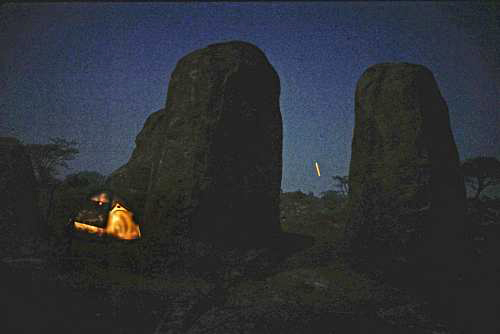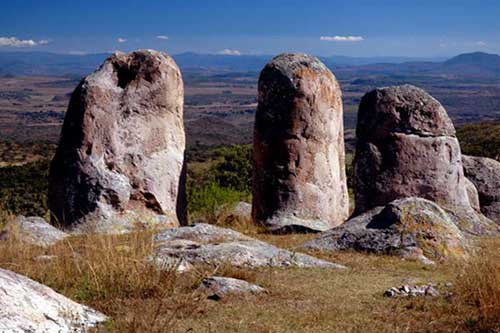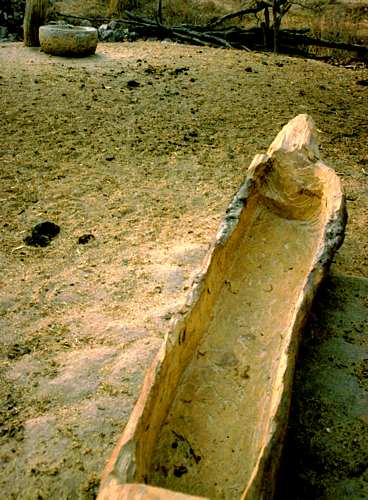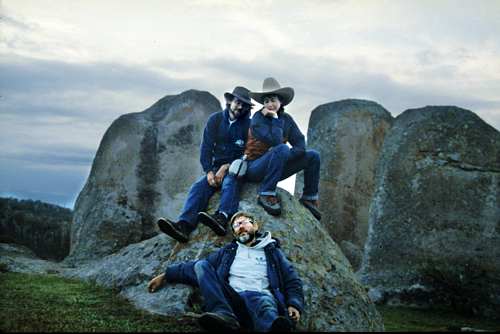Camping among the monoliths.That's our tent on the left.

RETURN TO LAS AGUILAS
© 2007 by John and Susy Pint

AS FASCINATING AS EVER, BUT IS IT
REALLY MEXICO’S STONEHENGE?
I heard about Las Aguilas over fifteen years ago, when a local citizen of Cuautla, Señor Miguel Mora, told us it was “Mexico’s answer to Stonehenge:” an ancient astronomical observatory and much more. Well, we talked to an astronomer, who told us to visit the place on an “astronomically significant day” and to keep our eyes open at sunrise and sunset...
| ...So there
we were on the day of the Zenith, setting up our tripods before dawn
...
Camping among the monoliths.That's our tent on the left. |
 |
|
...and our reward was to witness a spectacular
scene as the rising sun peeped up between two great standing monoliths and cast
a V-shaped shadow on a curious marker rock shaped like a pyramid with a snowball
on top.
|
 |
December 22, 2007. Of course, we wondered how this site has fared with the passage of time, so it was with a bit of trepidation that we headed for Cuautla not long ago. First we went to the Presidencia Municipal to try to find Mr. Mora, chief promoter of Las Aguilas, whom, we discovered, was out of town. This was not surprising, because we were told that most of Cuautla’s citizens live in the USA, where they run some 300 Mexican restaurants, all in the State of Washington. Cuautla itself has been described as “a very rich ghost town.”
“How about a guide to the Piedras, where can we find one?” we asked. “Bueno, if
you want a guide, we recommend Michael.” Here is where we learned that, because
of the small size of its permanent population, everyone in town knows everyone
else on a first-name basis.
Michael turned out to be a good-humored, gangly teenager whose name was actually
Manuel. “Why do they call you Michael?” I asked.
Because I like to sing—you know, like Michael Jackson,” he replied. “Do you want
me to show you Las Piedras?”
Michael took us to an unlocked gate on the highway and we discovered we could drive along a dirt road in great shape to a wide, flat grassy meadow with nice shade trees: just about the most perfect camping spot you could imagine, with a great view of the famous rock-covered peaks in the near distance. Here we parked and began walking southward along a trail through an idyllic valley,
|
Start of the Walk |
|
|
|
|
 |
| .....A little farther along, you come
to a spring-fed lagoon. At the far end of it, you pass through two cow gates
and follow a trail up to the top.
|
 |
After only a half-hour walk, we stepped through a cow-gate into another world...
|
...Rocks, rocks, everywhere—and with such strange and wonderful shapes! Most of them are smoothly sculpted by nature and few are more than a meter or two taller than a human. Just wandering among them is hypnotic. Time flies by as you feast your eyes on Mother Nature’s ever-changing show. “This is what I can do with rocks,” she seems to say.
|
 |
| I was happy to find the tall monoliths the same as they were fifteen years ago, completely free of graffiti or damage. Michael told us he had witnessed an amazing scene there on March 21, the day of the equinox. “The sun rose exactly between the monoliths and a narrow strip of light appeared on the ground, illuminating the marker rock. This strip of light only appeared on the 21st, not the day before nor the day after.” Unfortunately, the enthusiasm of the people of Cuautla is
not shared by experts in the know. Archeologist Phil Weigand tells me he has
visited Las Aguilas, agrees it is an impressive place, but says all the
evidence indicates that these picturesque rocks are completely natural and
in no way modified for astronomical use. |
 |
It took us only a few minutes to walk to the hilltop supposedly dedicated to Magic. This area is virtually covered with a thick forest of standing stones. Hidden among them is a so-called cave, actually just an open space under a fallen monolith. Naturally, there are the usual stories about treasure hidden there. Good luck if you think you’ll find it!
It was getting late, but we still had time to take a look at the hill that the local people say was dedicated to religious ceremonies. Here we found a long, oval-shaped mound which looked like it ought to be archeologically important. This is the highest spot in the area, with a truly magnificent lookout point. It’s also the only place we saw petroglyphs, but these engravings were so old and faint that we could hardly make them out.
If you want to visit a really interesting, but little-known place, without expending too much energy, I suggest you head for Las Aguilas. The hills are only 160 meters above the valley and you should easily reach them in only half an hour after stepping out of your car.
In case you'd like to camp at Las Aguilas, here's an excerpt from our book, Outdoors in Western Mexico, on our first experience sleeping near the parking spot:We arrived at our campsite and were so inspired by the beautiful view of the hills covered with strangely shaped rocks, that we took little notice of the cows and bulls grazing all around us. But that night we discovered that these creatures apparently never sleep. Ominous footsteps and heavy breathing woke us at midnight and neither flashlights nor shouting could keep the visitors away from our fragile tent...
| ...The thought of
what it would be like if one of those huge hooves suffered a misstep was
unnerving. We ended up abandoning ship and seeking refuge in our truck,
which, for the duration of the night was shaken by the bulls' "cornazos"
("horny collisions") as they relentlessly attempted to get at the garbage we
had unwisely stowed beneath our vehicle...
|
 |
|
And when we started breakfast, we ended up with a crowd of uninvited guests! |
| ...Finally, here's a warning just in case you plan to
hike up to the monoliths in the wee hours of the morning to catch a dramatic
sunrise: Don't forget to look up at the sky--before you crawl out of your
tent!
|
 |
How to get there.
From Guadalajara, take Highway 80 southwest towards Barra de Navidad. If you’re
near Lake Chapala, you get to this same highway by driving northwest from
Jocotepec. After passing Juchitlán you'll come to several small lakes. Watch for
a sign indicating the turnoff to San Clemente. Turn Right, drive northwest
through San Clemente and Ayutla until you reach the wide turnoff to Cuautla
(signposted). Turn right and drive into town if you are looking for Michael the
guide. Otherwise continue straight past the turnoff and look for the first gate
on your left, at 13 Q 563585 2233618, if you have a GPS. The parking spot is 457
meters southeast of here, at 13 Q 563834 2233221. Now you start walking along a
trail heading south. You’ll pass a corral with a drinking trough and after about
750 meters you’ll come to a lagoon. On the far side of it, you pass through twin
cow gates (at 13 Q 564016 2232525) and follow the path uphill to the top. Time
from the Guadalajara Periférico to Cuautla: about two and one half hours. You’ll
probably get there quicker if you’re coming from Chapala.
By John Pint
|
|
Aliens William Pint (foreground) and Felicia Dale